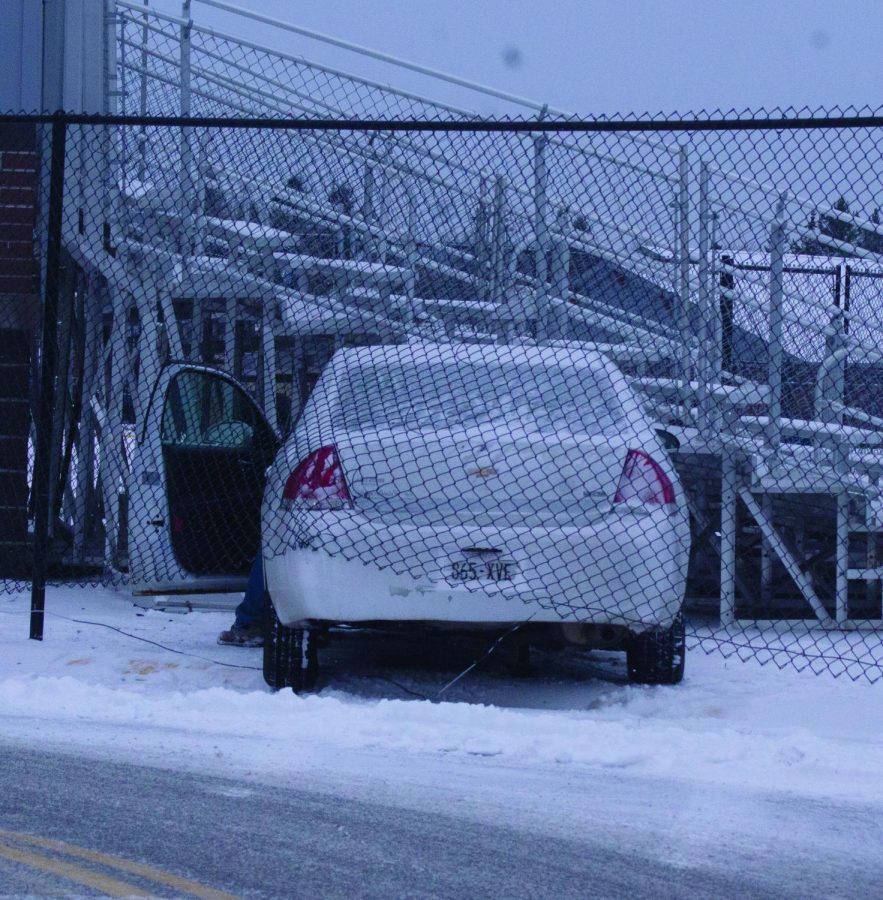Student crashes car hitting bleachers
Husemoller’s car bashed in bleachers on his way to hockey tryouts Nov. 13. Husemoller and his car are fine after the crash.
November 17, 2019
Early in the snowy morning of Nov. 13, junior Harrison Husemoller was driving within the school property when he suddenly crashed into the fence surrounding the softball field. Husemoller and his car ended up being fine after help from individuals from the police department, and the school district.
“This morning was the first time that I have been driving in snow this bad,” Husemoller said.
Husemoller was on his way to hockey tryouts before the accident happened. Tryouts were at 6 a.m., and his car did not get removed until after the start of the school day. This meant that students and faculty had at least two hours to witness the scene.
“I was coming into the school from 28th street. I was driving down the road going around 10 to 15 mph,” Husemoller said.
There was more information to how the accident happened. Husemoller said that after he started to turn the corner, he lost traction with the road. He continued to go straight until he went up and over the curb and into the fence.
Although Husemoller claims that he was going under 20 mph, other students in the school disagree with his notion.
On the day of the accident, physics teacher Jesse Samarziya created a lesson on the accident. Students in his AP Physics I class had to determine the initial velocity of Husemoller’s car. They took many aspects of the situation into their calculations.
Junior Jason Homann, who is in Samarziya’s class, gave some insight into what went on while the class was doing its calculations.
“The first thing we had to find out was the final velocity. That was 0, because the car was stopped,” Homann said. “We then had to research the coefficient of friction between the wet road and the tires of the car.”
Homann went on to explain how the class deciphered the rest of the equation. The class guessed that the distance that the car traveled was 40 meters, which was a lowball estimate. Homann says that in reality, the car was probably traveling faster than they calculated.
After the students’ calculations, they found out that Husemoller had to have been traveling at least 40 mph. This would be the minimum speed that he would have had to travel in order to make it over the cub and into the bleachers.
Clearly, the conclusions of Samarziya’s students, strongly contradict what Husemoller had said. While either could be true, it is interesting to see how great the difference is in what Husemoller had said to what the AP Physics I students had said.
Overall, Husemoller makes a good example of why drivers, and student drivers especially, should always pay attention to the condition of their vehicles. No matter what happens, the more prepared a driver is for the winter weather, the safer they will be. Anyone who interested in learning more about winter safety, can pick up a copy of the Spartan Spin and read their feature, which is focused on being safe during the wintertime.




Caleb Zimpel • Dec 4, 2019 at 6:18 pm
yea that dude is totaly lying haha.
Jordan Michele • Nov 21, 2019 at 11:22 am
Good job Harry.
Kaydence Young • Nov 20, 2019 at 2:38 pm
Woah. Those AP students are extremely smart. Future careers in law enforcement!!!
Armella Lane • Nov 19, 2019 at 4:08 pm
Love how you connected it to the newspaper.